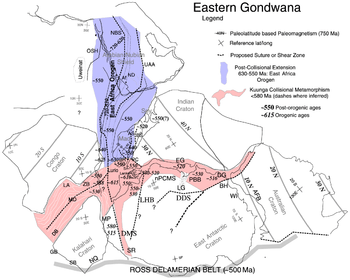East African Orogeny
The East African Orogeny (EAO) is the main stage in the Neoproterozoic assembly of East and West Gondwana (Australia–India–Antarctica and Africa–South America) along the Mozambique Belt.[2]

Gondwana assembly
The notion that Gondwana was assembled during the Late Precambrian from two older fragments along the Pan-African Mozambique Belt was first proposed in the early 1980s.[3] A decade later this continental collision was named the East African Orogeny, but it was also realised that this was not the simple bringing together of two halves. Rather, it was the piecemeal assembly of several much smaller cratonic elements that once formed an earlier supercontinent (today known as Rodinia), a process that eventually culminated in the relatively short-lived Gondwanan supercontinent.[2]
Two partly incomparable scenarios have been proposed for this assembly.[4] In one model, the EAO evolved from an accretionary orogeny involving the amalgamation of arcs and evolved into a collisional orogeny when the Neoproterozoic continent Azania collided with the Congo-Tanzania-Bangweulu Block at c. 640 Ma.[5] In another model, the assembly of East Gondwana c. 750 to 530 Ma was a multiphase process which included two main periods of orogenesis: the older EAO (c. 750 to 620 Ma) and the younger Kuunga Orogeny (c. 570 to 530 Ma).[6] In the former scenario the Kuunga Orogeny of the latter scenario are two coeval events: the collisions between India and Australia-East Antarctica and Azania and India. Furthermore, the two orogens of the latter scenario intersect in Madagascar, the proposed location of the Azania-India collision, and this part of the Kuunga Orogeny should be renamed the Malagasy Orogeny.[7]
Erosion and Cambrian explosion
The East African orogeny resulted in the formation of an enormous mountain chain, known as the Transgondwanan Supermountain, which was more than 8,000 km (5,000 mi)-long and 1,000 km (620 mi)-wide. The sedimentary deposition from this mountain chain, known as the Gondwana Super-fan, exceeded 1,000,000 km3 (240,000 cu mi) or the equivalent to covering the United States with c. 10 km (6.2 mi) of sediment, lasted for 260 million years and coincided with the Cambrian explosion, the sudden radiation of animal (Metazoan) life c. 550 Ma. These unprecedented sedimentary depositions probably made the diversification of early animal life possible.[8]
The orogen was eroded to such extent that by the Ordovician epoch it had been leveled to a planation surface in Ethiopia.[9][10]
Cenozoic reopening
The Cenozoic East African Rift System mostly evolved along the complex pattern of Proterozoic prerift systems in eastern Africa.[11] It passes through the Mozambique Belt east of the Tanzania Craton.[12]
References
- Meert 2003, Fig. 10, p. 19
- Stern 1994, pp. 320–321, 324
- McWilliams 1981, Abstract
- For a discussion see Meert 2003, Discussion, p. 31; Collins & Pisarevsky 2005, Comparisons with other models, pp. 256–257; Meert & Lieberman 2008, Assembling Gondwana: polyphase or simple?, pp. 9–11; Nance, Murphy & Santosh 2014, Pannotia (Gondwana), pp. 12, 14
- Azania was defined by Collins & Windley 2002, Discussion, pp. 334–335 and named by Collins & Pisarevsky 2005, p. 244
- Meert 2003, Abstract
- Collins & Pisarevsky 2005, Comparisons with other models, pp. 256–257
- Squire et al. 2006, Abstract
- Abbate, Ernesto; Bruni, Piero; Sagri, Mario (2015). "Geology of Ethiopia: A Review and Geomorphological Perspectives". In Billi, Paolo (ed.). Landscapes and Landforms of Ethiopia. World Geomorphological Landscapes. pp. 33–64. doi:10.1007/978-94-017-8026-1_2. ISBN 978-94-017-8026-1.
- Coltorti, M.; Dramis, F.; Ollier, C.D. (2007). "Planation surfaces in Northern Ethiopia". Geomorphology. 89 (3–4): 287–296. doi:10.1016/j.geomorph.2006.12.007.
- Ring 1994, Conclusions, p. 325
- Aulbach, Rudnick & McDonough 2011, Geology and samples, pp. 106–108
Sources
- Aulbach, S.; Rudnick, R. L.; McDonough, W. F. (2011). Evolution of the lithospheric mantle beneath the East African Rift in Tanzania and its potential signatures in rift magmas. Geological Society of America Special Papers. 478. pp. 105–125. doi:10.1130/2011.2478(06). ISBN 978-0-8137-2478-2. Retrieved 6 January 2018.CS1 maint: ref=harv (link)
- Collins, A. S.; Pisarevsky, S. A. (2005). "Amalgamating eastern Gondwana: The evolution of the Circum-Indian Orogens". Earth-Science Reviews. 71 (3–4): 229–270. Bibcode:2005ESRv...71..229C. CiteSeerX 10.1.1.558.5911. doi:10.1016/j.earscirev.2005.02.004.
- Collins, A. S.; Windley, B. F. (2002). "The tectonic evolution of central and northern Madagascar and its place in the final assembly of Gondwana" (PDF). The Journal of Geology. 110 (3): 325–339. Bibcode:2002JG....110..325C. doi:10.1086/339535. hdl:2440/34282. Retrieved 6 January 2018.CS1 maint: ref=harv (link)
- McWilliams, M. O. (1981). Palaeomagnetism and Precambrian tectonic evolution of Gondwana. Developments in Precambrian Geology. 4. pp. 649–687. doi:10.1016/S0166-2635(08)70031-8. ISBN 9780444419101.CS1 maint: ref=harv (link)
- Meert, J. G. (2003). "A synopsis of events related to the assembly of eastern Gondwana" (PDF). Tectonophysics. 362 (1): 1–40. Bibcode:2003Tectp.362....1M. doi:10.1016/S0040-1951(02)00629-7. Retrieved 6 January 2018.CS1 maint: ref=harv (link)
- Meert, J. G.; Lieberman, B. S. (2008). "The Neoproterozoic assembly of Gondwana and its relationship to the Ediacaran–Cambrian radiation". Gondwana Research. 14 (1): 5–21. Bibcode:2008GondR..14....5M. doi:10.1016/j.gr.2007.06.007. S2CID 2814283.CS1 maint: ref=harv (link)
- Nance, R. D.; Murphy, J. B.; Santosh, M. (2014). "The supercontinent cycle: a retrospective essay". Gondwana Research. 25 (1): 4–29. Bibcode:2014GondR..25....4N. doi:10.1016/j.gr.2012.12.026.CS1 maint: ref=harv (link)
- Ring, U. (1994). "The influence of preexisting structure on the evolution of the Cenozoic Malawi rift (East African rift system)". Tectonics. 13 (2): 313–326. Bibcode:1994Tecto..13..313R. doi:10.1029/93TC03188. Retrieved 6 January 2018.CS1 maint: ref=harv (link)
- Squire, R. J.; Campbell, I. H.; Allen, C. M.; Wilson, C. J. (2006). "Did the Transgondwanan Supermountain trigger the explosive radiation of animals on Earth?" (PDF). Earth and Planetary Science Letters. 250 (1): 116–133. Bibcode:2006E&PSL.250..116S. doi:10.1016/j.epsl.2006.07.032. Retrieved 11 September 2017.CS1 maint: ref=harv (link)
- Stern, R. J. (1994). "Arc assembly and continental collision in the Neoproterozoic East African Orogen: implications for the consolidation of Gondwanaland" (PDF). Annual Review of Earth and Planetary Sciences. 22 (1): 319–351. Bibcode:1994AREPS..22..319S. doi:10.1146/annurev.ea.22.050194.001535. Retrieved 6 January 2018.CS1 maint: ref=harv (link)